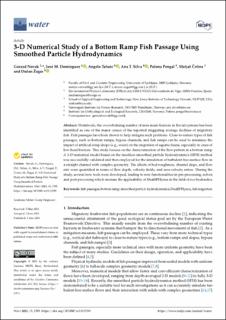| dc.contributor.author | Novak, Gorazd | |
| dc.contributor.author | Domínguez, José M. | |
| dc.contributor.author | Tafuni, Angelo | |
| dc.contributor.author | Silva, Ana T. | |
| dc.contributor.author | Pengal, Polona | |
| dc.contributor.author | Četina, Matjaž | |
| dc.contributor.author | Žagar, Dušan | |
| dc.date.accessioned | 2022-12-14T11:21:17Z | |
| dc.date.available | 2022-12-14T11:21:17Z | |
| dc.date.created | 2021-06-07T10:43:01Z | |
| dc.date.issued | 2021 | |
| dc.identifier.citation | Water. 2021, 13 (11), . | en_US |
| dc.identifier.issn | 2073-4441 | |
| dc.identifier.uri | https://hdl.handle.net/11250/3037669 | |
| dc.description.abstract | Worldwide, the overwhelming number of man-made barriers in fluvial systems has been identified as one of the major causes of the reported staggering average declines of migratory fish. Fish passages have been shown to help mitigate such problems. Close-to-nature types of fish passages, such as bottom ramps, bypass channels, and fish ramps can be used to minimize the impact of artificial steep drops (e.g., weirs) on the migration of aquatic fauna, especially in cases of low-head barriers. This study focuses on the characterization of the flow pattern in a bottom ramp. A 3-D numerical model based on the meshless smoothed particle hydrodynamics (SPH) method was successfully validated and then employed for the simulation of turbulent free-surface flow in a straight channel with complex geometry. The effects of bed roughness, channel slope, and flow rate were quantified in terms of flow depth, velocity fields, and area-velocity ratios. During the study, several new tools were developed, leading to new functionalities in pre-processing, solver, and post-processing which increase the applicability of DualSPHysics in the field of eco-hydraulics. fish passages; bottom ramp; smoothed particle hydrodynamics; DualSPHysics; fish migration | en_US |
| dc.language.iso | eng | en_US |
| dc.rights | Navngivelse 4.0 Internasjonal | * |
| dc.rights.uri | http://creativecommons.org/licenses/by/4.0/deed.no | * |
| dc.title | 3-D Numerical Study of a Bottom Ramp Fish Passage Using Smoothed Particle Hydrodynamics | en_US |
| dc.type | Peer reviewed | en_US |
| dc.type | Journal article | en_US |
| dc.description.version | publishedVersion | en_US |
| dc.rights.holder | © 2021 The Authors | en_US |
| dc.subject.nsi | VDP::Zoologiske og botaniske fag: 480 | en_US |
| dc.subject.nsi | VDP::Zoology and botany: 480 | en_US |
| dc.source.pagenumber | 19 | en_US |
| dc.source.volume | 13 | en_US |
| dc.source.journal | Water | en_US |
| dc.source.issue | 11 | en_US |
| dc.identifier.doi | 10.3390/w13111595 | |
| dc.identifier.cristin | 1914093 | |
| dc.relation.project | Andre: MinistryEcon and Competitiveness, Government of Spain | en_US |
| dc.relation.project | Andre: European Regional Development Fund (ERDF) | en_US |
| dc.relation.project | Andre: Xunta de Galicia (Spain) | en_US |
| dc.relation.project | Andre: Slovenian Research Agency (ARRS) | en_US |
| cristin.ispublished | true | |
| cristin.fulltext | original | |
| cristin.qualitycode | 1 | |

